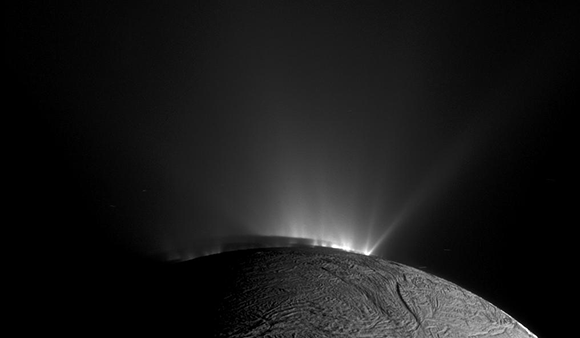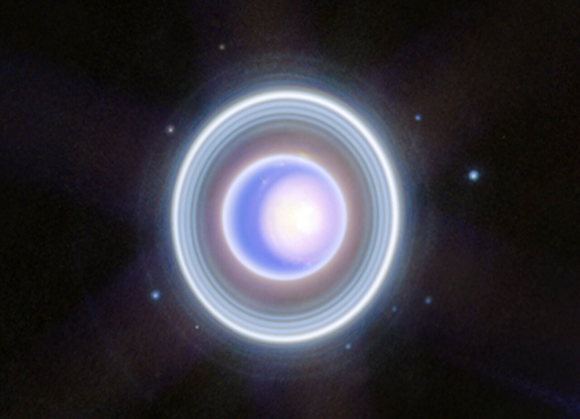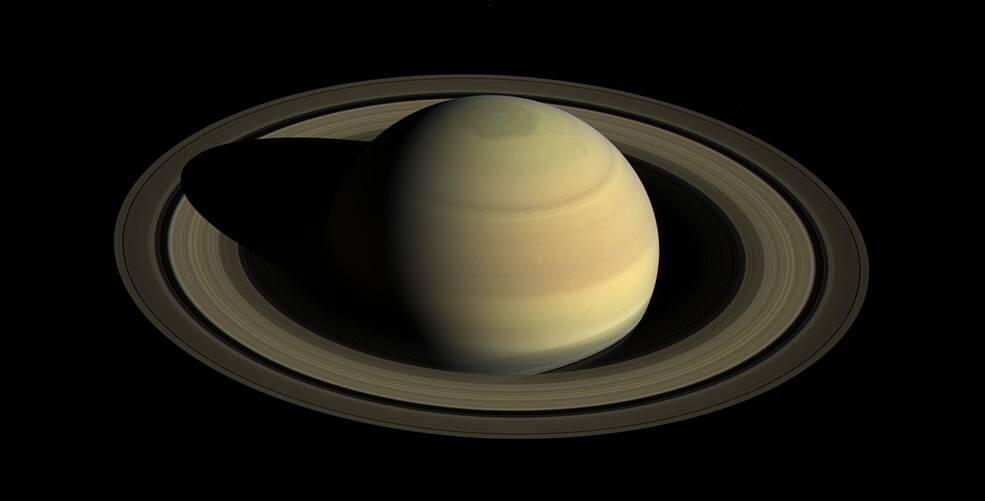Enceladus, one of the larger moons of the planet Saturn, appears frozen and desolate from above. But beneath its outer ice layer, lies an ocean of liquid water bustling with chemical activity.
More stories:
Previous investigations suggested the presence of simple molecules like carbon dioxide (CO2), methane (CH4), and ammonia (NH3) in these waters. Recent data analysis now suggests the existence of more complex substances in the atmosphere of Enceladus, sparking the hopes of scientists that the presence of organic molecules, such as carbon compounds, may indicate the potential presence of some forms of life within this enigmatic dark ocean.
4 View gallery


Do these plumes contain evidence of life? The plumes emitted from the south pole of Enceladus in an image by the Cassini spacecraft from 2010
(Photo: NASA/JPL-Caltech/Space Science Institute)
Despite the ocean being beneath many kilometers of ice, its waters can be sampled through a "geyser" – a jet of water that erupts into space from the moon's south polar region. The Cassini spacecraft, which diligently studied Saturn, its rings, and its moons for 13 years until its mission concluded in 2017, took advantage of this phenomenon.
The spacecraft ventured through the vapor plume, collected samples, and meticulously analyzed their composition using a mass spectrometer, a device that measures the mass and electric charge of particles to determine chemical composition. This is how the simple molecules mentioned earlier were found, which alongside water molecules (H2O) constituted the majority of the sample's content.
Now, several years after the spacecraft's deliberate crash, researchers at NASA's Jet Propulsion Laboratory (JPL) in Southern California decided to re-examine the spectrometer data, employing sophisticated mathematical techniques for a more detailed analysis. Their objective was to uncover the chemical signatures of less common molecules within the samples.
In an article published in Nature Astronomy, they reported discovering larger and more complex molecules, including hydrogen cyanide (HCN), acetylene (C2H2), propylene (C3H6), ethane (C2H6), methanol (CH3OH), and more.
“Our work provides further evidence that Enceladus is host to some of the most important molecules for both creating the building blocks of life and for sustaining that life through metabolic reactions,” said Johan Peter, a Ph.D. student at Harvard University who led the research while working as part of an internship at JPL.
“Not only does Enceladus seem to meet the basic requirements for habitability, we now have an idea about how complex biomolecules could form there, and what sort of chemical pathways might be involved.”
Researchers estimate that Saturn's strong gravitational forces lead to the expansion and contraction of the cores of its neighboring moons, including Enceladus, thus generating heat. This dynamic process generates an internal heat source, which enables the sustainment of a liquid ocean at such a great distance from the sun and is likely responsible for the chemical processes that enable the formation of relatively complex molecules, and it may even create conditions conducive to the emergence of actual living organisms, akin to the processes observed in geothermal springs on Earth's ocean floors.
Several mission plans aimed at exploring this subterranean ocean are currently under consideration, with none having progressed to actionable missions as of yet. Recently, a researcher from the University of Arizona proposed a novel approach to investigate the ocean's composition using a probe that would land on the moon’s surface. This approach eliminates the need to descend into the ocean or pass through the plumes again.
According to the researcher, Amanda Hendrix, the majority of the material ejected from the geyser settles in the vicinity. While the upper layers are exposed to potentially degrading ultraviolet radiation, they effectively filter out most of the radiation, and the layers beneath them could potentially retain their original state upon eruption.
“Now we know that you can land on the surface and be confident that your instruments can measure relatively pristine plume organics – sourced from the ocean,” said Hendrix. “We know that Enceladus’ ocean is habitable thanks to Cassini measurements. We know there is liquid water, energy, and the chemicals carbon, hydrogen, nitrogen, oxygen, phosphorus and sulfur. These are the ingredients necessary for life as we know it.”
Uranus as never seen before
These days mark two years since the launch of the James Webb Space Telescope, and NASA has recently published a new image captured by the telescope, which offers an unprecedented glimpse of the intricate system surrounding the planet Uranus.
4 View gallery


The infrared imaging reveals new layers of the enigmatic ice world in our solar system. Uranus, its rings, and some of its moons, as captured by the James Webb Space Telescope
(Photo: NASA, ESA, CSA, STScI)
Earlier in April this year, the agency released another image of Uranus taken by the telescope, using two wavelengths found outside the visible light spectrum. The latest image was captured using at least four different wavelengths, and it provides a stunningly detailed view of Uranus’s ring system, which was first discovered in 1977. It also clearly shows the elusive Zeta ring, a thin inner ring notoriously challenging to detect. Additionally, the image captures nine of Uranus's 27 known moons.
In visible light, Uranus appears as a blue sphere, but observing it at various infrared wavelengths reveals a wealth of details, including the seasonal ice cap at its south pole, and the dynamic storms raging within its atmosphere. Beyond the captivating beauty of the image, the data obtained from the space telescope will be instrumental in planning future missions to Uranus.
Remarkably, only one spacecraft, Voyager 2, has ever made a close encounter with Uranus, capturing detailed images in 1986. Uranus also plays a pivotal role in exoplanet studies, serving as a comparative model for exoplanets found in distant solar systems. To date, astronomers have identified approximately two thousand exoplanets of similar size to Uranus, some of which also share other characteristics with this planet.
The cat launched from space
The American spacecraft Psyche was launched about two months ago with a mission to explore intriguing objects within the asteroid belt, situated between the orbits of Mars and Jupiter.
Recently, it also played a pioneering role as a testbed for cutting-edge technology: broadband communication via infrared laser. The information transmitted by Psyche during this experiment did not consist of typical scientific data, such as close-up asteroid images or other scientific measurements. Instead, it was a whimsical video of a cat named Taters, chasing a laser pointer's light spot. As a result, the cat quickly became an internet sensation.
The technology demonstrated the broadcasting of high-definition video from a distance of 31 million kilometers, at a speed of 267 megabits per second (Mbps), exceeding even the average internet bandwidth within the United States. One of the experiment participants mentioned that after receiving the video at the telescope station in California, it was transmitted to the JPL offices, also in California, and that this transfer actually took longer than receiving the broadcast from space.
“Increasing our bandwidth is essential to achieving our future exploration and science goals,” said NASA Deputy Administrator Pam Melroy. “We look forward to the continued advancement of this technology and the transformation of how we communicate during future interplanetary missions.”
Back in blue
The company "Blue Origin", which operates tourist flights to the edge of space, has resumed its launch operations after a 15-month hiatus following an explosion of its launch rocket, New Shepard, in September 2022.
The new rocket was launched last Tuesday from the company's West Texas space base, and its first stage completed a soft landing back at the launch site shortly thereafter. The mission was unmanned and carried 33 scientific experiments: about half of them originating from NASA or being developed in collaboration with the space agency, and the rest belonged to universities, schools, and other organizations dedicated to promoting scientific and space education.
The company has not yet announced the schedule for their next launch, nor has it reported when it intends to resume manned flights. Its competitor in the field of tourist flights to the edge of space, Virgin Galactic, recently launched several flights and is expected to launch another in January.
However, Virgin Galactic has also recently announced a temporary suspension of these activities for two years to prioritize the development of next-generation spaceplanes, a strategic decision that comes amidst financial challenges that pose a threat to their ongoing operations.
- Content distributed by the Davidson Institute of Science



